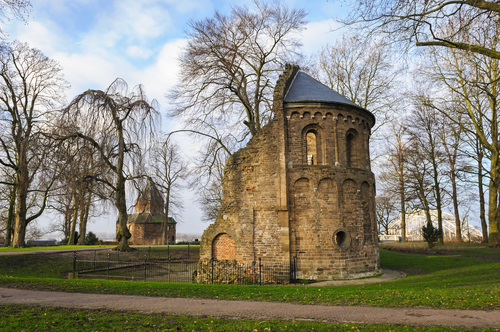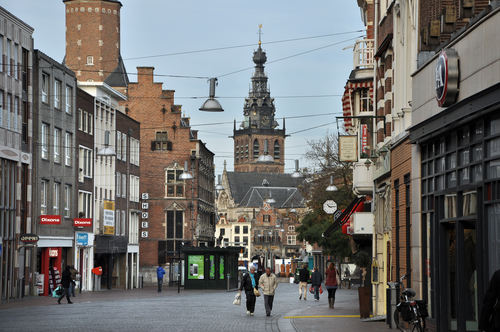Nijmegen – From Barbarossa to Bob Hope

For a city as modestly-sized as Nijmegen, it has a significant place in Dutch history. In fact, it is thought to be the oldest city in the Netherlands, and in 2005 celebrated its 2000th anniversary. Stephanie Dijkstra finds out more.
When the Romans arrived in the area and set up camp, the camp was quickly accompanied by a new market: Novio Magnum – and with a little bit of imagination, you will realise this is the origin of the name Nij-Megen. It was home to 12,000 Roman soldiers, and was flanked by Oppidum Batavorum, or City of the Batavi, which was inhabited by Roman civil servants, tradesmen and a few Batavi (an ancient Germanic tribe).
In 270, after squashing a Batavi uprising, the Romans built a fort which later came into the hands of the Franks and even later became part of the empire of Charlemagne. This fort was destroyed and rebuilt over a period of centuries, until Barbarossa (Red Beard, Holy Roman Emperor and King of Italy, Germany and Burgundy) decided this was where he wanted to build a castle. Today, you can still visit the Barbarossa ruin, located in what is now called Valkhof Park.
A visit to Museum het Valkhof in the city centre will allow you to witness some of the archaeological finds made in the city. The museum itself is a delight in many ways: the entire back wall is made of glass, offering a view of the tree-lined pathway behind it and giving you the feeling you are taking a walk through the woods every time you enter the main passageway. And the rooms, with their collections of objects from prehistory, the Romans and the Middle Ages – as well as other exhibitions – are light and far from stuffy.
Students
Nijmegen is what the Dutch call a ‘student city’; it is home to Nijmegen’s Radboud University, as well as to the HAN hbo college. All in all, almost 39,000 students live in the city, making up 29% of its population.
My tour of Nijmegen started at the Valkhof Museum and from there took us through the city centre. It was a sunny Saturday and the town was full of students, locals, young couples with children and a sprinkling of Germans, as Nijmegen is just a few miles from the German border.

First stop was Bairro Alto (which you will recognise by the words Hollandsche Spoorweg written over its window), Nijmegen’s answer to Starbucks. Housed in a former travel bureau and ticket office built for the Dutch railroad company, it is now a cozy place to stop for a cup of coffee or tea, as well as salads and sandwiches. You can even pick up a picnic basket and blanket (which you return when you are done).
From there, it is a short walk to the Grote Markt, which you cross to go through an archway leading to a quaint little street that wraps around the Stevenskerk which dates from the 13th century. The church itself is magnificent in resplendent white and gold, with a gleaming stone floor and the tombs of many local dignitaries, including that of Catherine of Bourbon.
American bombers
Beside the Romans, Nijmegen was also involved in another, more recent, important chapter of this nation’s history: World War II. On February 22, 1944 16 American bombers – presumably mistaking Nijmegen for a German town – dropped their bombs, killing 800 people and ruining substantial portions of the inner city, including the tower of the Stevenskerk.
Then, just seven months later, in September 1944, Operation Market Garden started; an unsuccessful Allied attempt at securing the bridges across the river Meuse, the lower Rhine and the Waal so they could enter the German lowlands while avoiding its Siegfried defence line.

As part of their efforts, the Allies started to liberate Nijmegen, but the Germans defended it tooth and nail. The fighting drove out tens of thousands of local inhabitants and when the Germans left, a few days later, they set fire to what was left of the inner city.
Front line
But that was not the end because Nijmegen was now on the new front line, and Germany bombed the city time and again, trying to destroy the bridges which were still intact. In short, during the last few months of the war Nijmegen found itself in the middle of a battlefield. By the end of the war, some 2,200 people had been killed and 10,000 wounded; 5,000 homes and 500 shops were destroyed and 12,000 people were left homeless.
Nevertheless, during the war, Nijmegen became a popular place for allied soldiers who were on leave. At a certain point it was home to 150,000 allied soldiers – almost twice as many as there were local inhabitants – and was visited by both Bob Hope and Vera Lynn.
This created something of a dilemma after the war, when the local inhabitants, well aware of who had dropped the bombs on February 22, were torn between their appreciation of the allied soldiers and the naked fact of the bombing. As a consequence, the bombing was swept under the carpet for decades afterwards; only recently becoming a topic that could be discussed openly.
Rebuilding
After the war, the city focused on rebuilding and repairing the damaged buildings – unlike Rotterdam, for instance, which only aimed for a return of 10% of its historical appearance.
And now, the city is working on another ambitious project. In 1995, after a surge of water, caused by heavy rains in Germany and France, threatened the people of Nijmegen, the city decided something had to change. Instead of merely strengthening its dykes, it moved them 350 metres further back, creating a wider flood plain for the Waal.
As they have done throughout history, the Dutch have come up with innovative and impressive plans that will not only ensure a city’s safety, but also its beauty, its atmosphere – and room for growth.
Thank you for donating to DutchNews.nl.
We could not provide the Dutch News service, and keep it free of charge, without the generous support of our readers. Your donations allow us to report on issues you tell us matter, and provide you with a summary of the most important Dutch news each day.
Make a donation